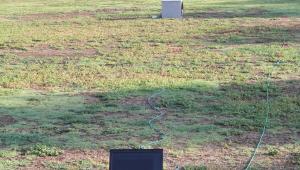Review: NuForce Cube Page 2
Measurements
I measured the Cube with the microphone placed at a distance of 0.5 meters (adequate to capture diffraction effects off the enclosure, and close enough to deliver a reasonable level at the mic), with the speaker atop a 2-meter-high stand, using quasi-anechoic technique to remove the effects of reflections from nearby objects. To get the “bass response,” I placed the mic 6 inches from the front grille, so that I could measure the combined response of the driver and what appears to be a tiny port in the front baffle. The curves you see in the accompanying chart show the on-axis response (blue trace) and the average of measurements at 0°, ±10°, ±20°, and ±30°(green trace). All frequency response measurements were made with a Clio FW audio analyzer then imported into a LinearX LMS analyzer for post-processing. All curves are smoothed to 1/12th octave.
The measurements of the Cube are pretty good for a product like this. Measured up to 10 kHz, it’s comparable to many of the conventional speakers we measure. Above that, there’s a big resonance at 14 kHz, and a drop in response above that, but we’re talking such high frequencies here that the effect of this anomaly won’t be terribly noticeable. Obviously, the balance is somewhat treble-heavy, with the range between 2 and 10 kHz boosted by +4 to +5 dB. Averaged response across the ±30° listening window is almost identical to the on-axis response. The -3 dB bass response is 153 Hz.
To gauge the Cube’s maximum output level, I used my MCMäxxx™ test — i.e., I played the Mötley Crüe track “Kickstart My Heart,” turned up the level until I encountered audible distortion in the vocals, then backed the volume off one notch and measured the average output at 1 meter. I got 82 dB SPL, which is +1 dB better than the FoxLv2 and +4 dB better than the Jambox. (Of course, it’s easier to play loud when you don’t even try to do bass.)
So for what it is, the Cube measures OK.
Bottom Line
As an extension speaker for smartphones, MP3 players, and computers, the Cube is truly superb. No, it’s not going to give you room-filling sound or big bass (or any bass, for that matter), but it does deliver shockingly clear midrange and treble. It also works well as a USB headphone amp for those who want better sound from their computer, although it’s not a great choice for use with headphones of below-average sensitivity. IT seems to me that the killer app for the Cube is as a travel system, something you can toss into your suitcase to use as a headphone amp or extension speaker in your hotel room. Because any trip is better with good sound.





























































